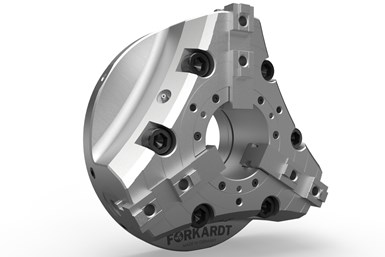Forkardt's FNC+ Chuck Extends Compatible Weights and RPM
Forkardt’s revisions to the FNC+ Quick Jaw Change Power Chuck increase its versatility, expanding the compatible range of RPMs and workpiece weights.
Share






Hardinge brand Forkardt has announced its newly upgraded FNC+ Quick Jaw Change Power Chuck, a universally applicable wedge-style power chuck that offers increased versatility and manufacturing efficiencies, as well as reduced set up time.
A revised base jaw profile allows the chuck to accept straight-tooth base jaws from competitive brands. This allows users to continue to utilize their current inventory of base jaws, irrespective of brand. Forkardt’s FNC+ is also compatible with angled base jaws. In addition, an enlarged through-hole can meet the needs of today’s machine tool builders and dealers.
FNC+’s reduced chuck body weight results in less mass on the spindle, enabling machine manufacturers to use a higher workpiece weight and attain higher RPMs. The low overall height permits customers to machine longer parts and increases the usable work envelope of the machine.
A piston safety device means the FNC+ can be easily and safely mounted on vertical spindles, and the clamping chuck jaws can now only be unlocked, adjusted and changed with the original actuating key.
The chuck now mounts to the spindle with six bolts instead of three, heightening the rigidity of the chuck body.
The 3FNC+ is available in straight or angled serration versions in sizes 185 - 630.
Related Content
-
Prioritizing Workholding Density Versus Simplicity
Determining whether to use high-density fixtures or to simplify workholding requires a deeper look into the details of your parts and processes.
-
Rail Manufacturer Moves Full Steam Ahead with Safe, Efficient Workholding Solution
All World Machinery Supply paired a hydraulic power unit with remote operating capabilities in a custom workholding system for Ahaus Tool & Engineering.
-
Workholding Fixtures Save Over 4,500 Hours of Labor Annually
All World Machinery Supply designs each fixture to minimize the number of operations, resulting in reduced handling and idle spindle time.
















